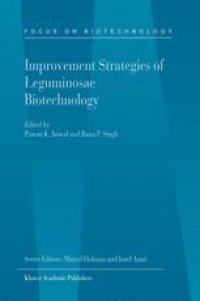
Ebook: Improvement Strategies of Leguminosae Biotechnology
- Tags: Plant Sciences
- Series: Focus on Biotechnology 10A
- Year: 2003
- Publisher: Springer Netherlands
- Edition: 1
- Language: English
- pdf
Legumes include many very important crop plants that contribute critical protein to the diets of many around the world. Many important forages and green manure crops are legumes. Legumes are also large contributors to the vegetable oil and animal feed protein sectors. One characteristic of legumes that could become even more important as world energy sources decline and nitrogen fertilizer prices increase is nitrogen fixation, something few other plants can do. Thus legumes have a unique and important niche in agriculture. While some of the small seeded forage legumes have been relatively easy to work with in tissue culture as far as culture initiation, plant regeneration and transformation are concerned, most large seeded legumes, like soybean, have been recalcitrant. Today, however, many laboratories are inserting genes into soybean and producing unique plants for both commercial and scientific uses. These advancements have taken a large amount of research effort and still require time and labour.
Volume 10A examines the current status and future prospects of challenges of the following: in vitro morphogenesis; biotic and abiotic stress tolerance; genomics; nitrogen fixation and utilization; nutritional improvement, and biodiversity of wild and tribal legumes.
Volume 10B presents the current state and future prospects of in vitro regeneration and genetic transformation expression and stability of transgenes modification of traits in almost all the important legumes, for example: soybean; peanut; pea; french bean; chick pea; pigeon pea; cowpea; mung bean; black gram; azuki bean; lentil; Lathyrus; lupinus; Lotus spp; Medicago spp; Trifolium spp; Winged bean; Guar; and tree legumes for their improvement. Written by international experts, these volumes will be of great value to researchers, as well as graduate students and all those requiring an advanced level overview of the subject area.
Volume 10A examines the current status and future prospects of challenges of the following: in vitro morphogenesis; biotic and abiotic stress tolerance; genomics; nitrogen fixation and utilization; nutritional improvement, and biodiversity of wild and tribal legumes.
Volume 10B presents the current state and future prospects of in vitro regeneration and genetic transformation expression and stability of transgenes modification of traits in almost all the important legumes, for example: soybean; peanut; pea; french bean; chick pea; pigeon pea; cowpea; mung bean; black gram; azuki bean; lentil; Lathyrus; lupinus; Lotus spp; Medicago spp; Trifolium spp; Winged bean; Guar; and tree legumes for their improvement. Written by international experts, these volumes will be of great value to researchers, as well as graduate students and all those requiring an advanced level overview of the subject area.
Content:
Front Matter....Pages i-xx
Front Matter....Pages 1-1
Breeding Methodologies for the Improvement of Grain Legumes....Pages 3-21
In Vitro Morphogenesis in Grain Legumes: An Overview....Pages 23-63
In Vitro Organogenesis....Pages 65-85
Somatic Embryogenesis....Pages 87-132
Protoplasts of Grain and Forage Legumes: Their Exploitation in Genetic Manipulation, Physiological Investigations and Plant-Pathogen Interactions....Pages 133-153
Wide Hybridization in Important Food Legumes....Pages 155-171
Front Matter....Pages 173-173
Perception and Processing of Nod Factor Signals....Pages 175-189
Nitrate Assimilation....Pages 191-199
Improvement of Nitrogen Utilization....Pages 201-220
Front Matter....Pages 221-221
Genetic Engineering for Enhancing Abiotic Stress Tolerance....Pages 223-243
Genetic Engineering for Insect Resistance....Pages 245-253
Genetic Engineering for Virus Resistance....Pages 255-268
Molecular Strategies for Fungal and Nematode Resistance....Pages 269-277
Front Matter....Pages 279-279
Improvement of Methionine-Deficient Legumes Through Genetic Engineering....Pages 281-290
Development of Regeneration Protocols to Exploit Somaclonal Variations in Lathyrus Sativus for Developing Toxin Free Cultivar....Pages 291-299
Front Matter....Pages 301-301
Organisation and Genetic Mapping of the Chickpea Genome....Pages 303-351
Biodiversity in Indian Underexploited/Tribal Pulses....Pages 353-405
Back Matter....Pages 407-411
Volume 10A examines the current status and future prospects of challenges of the following: in vitro morphogenesis; biotic and abiotic stress tolerance; genomics; nitrogen fixation and utilization; nutritional improvement, and biodiversity of wild and tribal legumes.
Volume 10B presents the current state and future prospects of in vitro regeneration and genetic transformation expression and stability of transgenes modification of traits in almost all the important legumes, for example: soybean; peanut; pea; french bean; chick pea; pigeon pea; cowpea; mung bean; black gram; azuki bean; lentil; Lathyrus; lupinus; Lotus spp; Medicago spp; Trifolium spp; Winged bean; Guar; and tree legumes for their improvement. Written by international experts, these volumes will be of great value to researchers, as well as graduate students and all those requiring an advanced level overview of the subject area.
Content:
Front Matter....Pages i-xx
Front Matter....Pages 1-1
Breeding Methodologies for the Improvement of Grain Legumes....Pages 3-21
In Vitro Morphogenesis in Grain Legumes: An Overview....Pages 23-63
In Vitro Organogenesis....Pages 65-85
Somatic Embryogenesis....Pages 87-132
Protoplasts of Grain and Forage Legumes: Their Exploitation in Genetic Manipulation, Physiological Investigations and Plant-Pathogen Interactions....Pages 133-153
Wide Hybridization in Important Food Legumes....Pages 155-171
Front Matter....Pages 173-173
Perception and Processing of Nod Factor Signals....Pages 175-189
Nitrate Assimilation....Pages 191-199
Improvement of Nitrogen Utilization....Pages 201-220
Front Matter....Pages 221-221
Genetic Engineering for Enhancing Abiotic Stress Tolerance....Pages 223-243
Genetic Engineering for Insect Resistance....Pages 245-253
Genetic Engineering for Virus Resistance....Pages 255-268
Molecular Strategies for Fungal and Nematode Resistance....Pages 269-277
Front Matter....Pages 279-279
Improvement of Methionine-Deficient Legumes Through Genetic Engineering....Pages 281-290
Development of Regeneration Protocols to Exploit Somaclonal Variations in Lathyrus Sativus for Developing Toxin Free Cultivar....Pages 291-299
Front Matter....Pages 301-301
Organisation and Genetic Mapping of the Chickpea Genome....Pages 303-351
Biodiversity in Indian Underexploited/Tribal Pulses....Pages 353-405
Back Matter....Pages 407-411
....